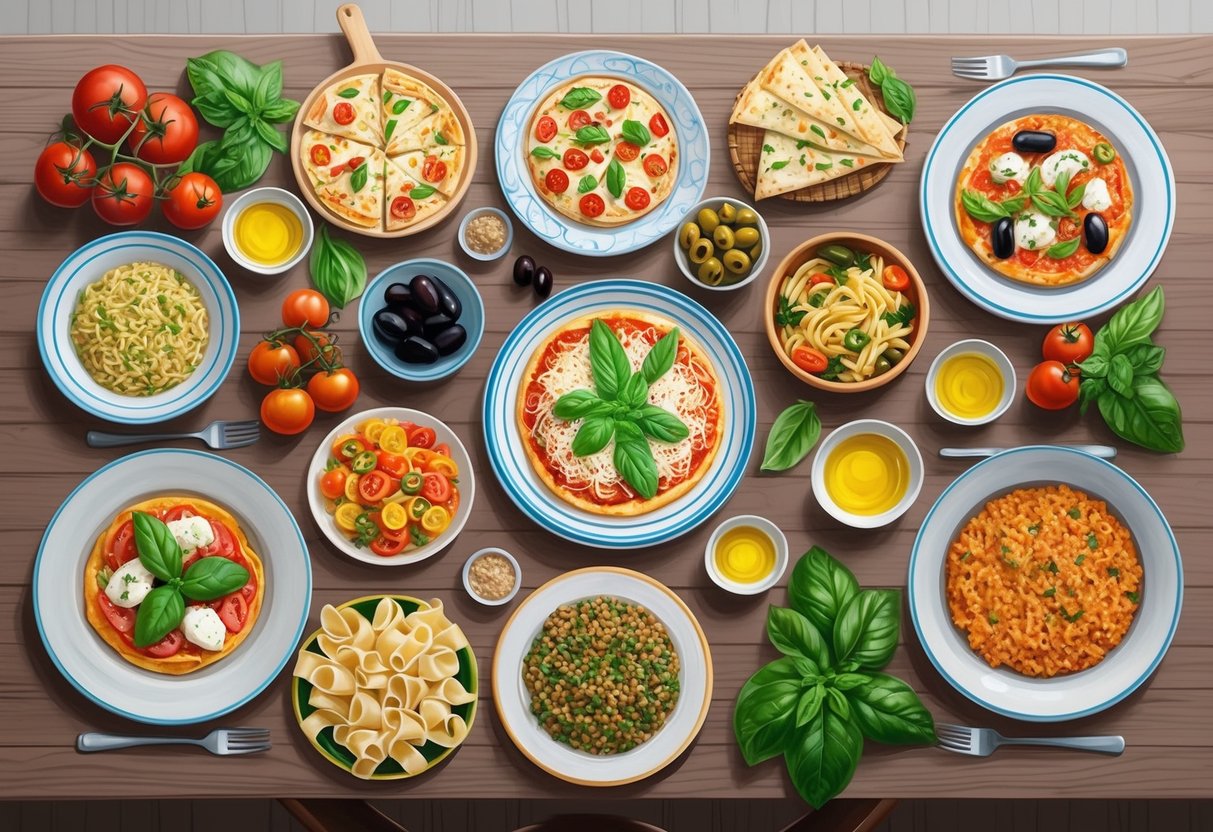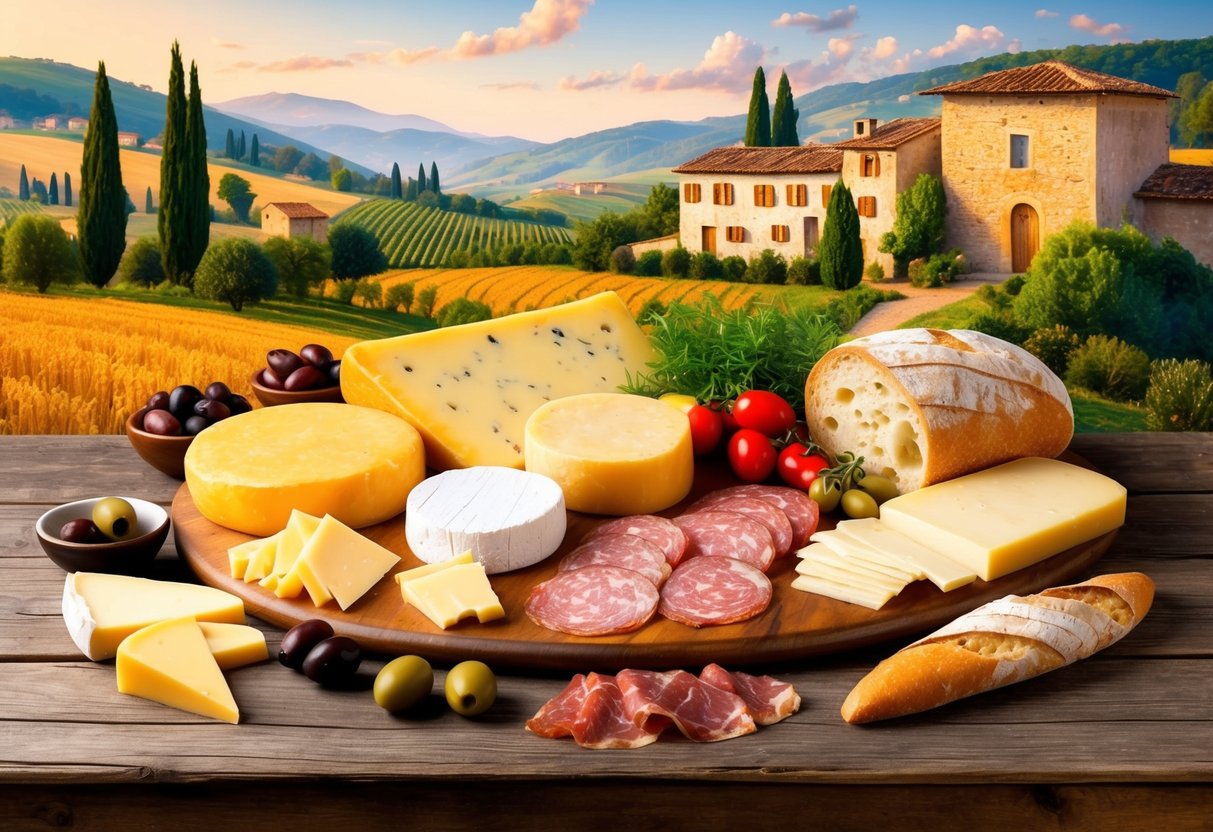
Beloved Italian Soups and Stews
Italian soups and stews are known for their use of seasonal vegetables, hearty grains, and rustic breads.
Regional specialties transform simple, everyday ingredients into deeply flavorful comfort foods with a strong sense of tradition.
Ribollita and Tuscan Bread Soups
Ribollita is a classic Tuscan soup built on stale Tuscan bread, cannellini beans, and vegetables like cavolo nero, carrots, and celery.
This dish gets its name, which means “reboiled,” from the custom of reheating leftovers to intensify flavor and texture.
Traditionally, it’s thick and almost stew-like, meant to be eaten with a fork rather than a spoon.
Another Tuscan staple is pappa al pomodoro, a tomato and bread soup flavored with garlic, basil, and olive oil.
The bread absorbs the tomato broth, creating a dense, comforting texture.
More about these classics can be found in lists of traditional Italian soup dishes.
Hearty Broths and Legume Soups
Across Italy, robust broth-based soups and legume stews are essential winter staples.
Minestrone, for example, combines fresh vegetables, beans, and pasta or rice in a light yet flavorful stock.
Regional variations may include different beans, such as cannellini, or unique local greens and herbs.
Soups like pasta e fagioli use small pasta shapes simmered with cannellini or borlotti beans and fragrant aromatics.
These soups often start with a base of onion, celery, and carrot, then layer in beans and grains.
Italian broths, whether clear or thick, are prized for their depth and satisfying richness.
Find a range of these classic recipes in Italian soup collections.
Signature Risotto and Rice Dishes
Italian cuisine is renowned for its creamy risottos and flavorful rice dishes.
These recipes showcase regional ingredients and meticulous cooking techniques.
Risotto Styles
Risotto is a versatile Italian specialty, most often prepared with short-grain rice such as Arborio or Carnaroli.
The hallmark of risotto is its creamy texture, developed by slow-cooking the rice and gradually adding hot chicken or vegetable broth.
Authentic methods call for toasting the rice in butter, then deglazing the pan with white wine.
Stirring consistently helps the rice release starches, creating a smooth, velvety consistency without the use of cream.
Grated Parmesan cheese is folded in at the end to impart extra richness and depth.
Distinct styles exist depending on the region.
In Milan, Risotto alla Milanese features saffron, which gives the dish a golden color and subtle aroma.
Elsewhere, variations may include mushrooms, seafood, or fresh vegetables.
The essential steps remain consistent: patience, stirring, and building flavor through quality ingredients and slow absorption of broth.
For more details on authentic preparation, see tips for making risotto the Italian way.
Classic Rice-Based Recipes
Italian rice dishes extend beyond risotto, offering a wide range of flavors and textures.
Recipes like “supplì” (Roman fried rice balls filled with mozzarella) and “arancini” (Sicilian rice balls, often stuffed with meat and peas) highlight the versatility of rice across Italy.
Other celebrated risotti include Risotto alla Romana and Risotto alla Milanese with saffron, each utilizing chicken broth, butter, and Parmesan cheese as foundational elements.
Recipes can feature different proteins—shrimp, chicken, beef—or be kept simple with mushrooms, asparagus, or truffle oil.
Rice also appears in soups and baked dishes, frequently paired with cheese, herbs, and tomato-based sauces.
These classics underscore the importance of rice in Italian culinary traditions, revealing diverse approaches to seasoning, filling, and serving.
Italian Cheeses and Cured Meats

Italy’s culinary tradition is rooted in careful aging, local ingredients, and deep respect for quality.
From the sharp tang of hard cheeses to the delicate flavor of prosciutto, these foods have earned global recognition and protected designations.
Famous Cheeses
Italian cheese varieties number in the hundreds, each bringing distinctive flavors to Italy’s cuisine.
Parmesan cheese, known in Italy as Parmigiano Reggiano, is celebrated for its savory, crystalline texture and is often grated over pasta and risotto.
Pecorino Romano is a firm, salty sheep’s milk cheese, frequently used as a finishing touch in Roman recipes like carbonara.
Mozzarella stands out for its fresh, mild taste and soft, pliable texture, essential in classic dishes such as Caprese salad and authentic pizza.
Cheeses such as Asiago range from smooth and mild when young to sharp and crumby when aged, offering flexibility in both table and cooking uses.
In fact, Italy produces approximately 600 types of cheeses, many steeped in local tradition and history.
Notable Italian Cheeses
| Cheese | Milk Source | Texture | Common Uses |
|---|---|---|---|
| Parmigiano Reggiano | Cow | Hard | Grated, eaten alone |
| Pecorino Romano | Sheep | Hard | Pasta, grating |
| Mozzarella | Buffalo/Cow | Soft | Pizza, salads |
| Asiago | Cow | Hard/Semi | Sliced, grated, snacking |
Traditional Cured Meats
Italy’s cured meats—called salumi—offer a rich variety of flavors, each with unique regional significance.
Prosciutto, perhaps the most iconic, is made from the hind leg of pork and aged until it develops its delicate, savory profile.
It’s often served thinly sliced with melon or as a topping for pizza.
Mortadella is a finely ground, seasoned pork sausage from Bologna, distinguished by its smooth texture and mild, aromatic taste.
Salami comes in a range of types, from spicy varieties like ‘nduja to milder versions such as Genoa salami.
Each salume is processed and cured using specific methods that reflect Italy’s diverse food culture.
They play a staple role in antipasto platters and sandwiches.
For more on Italian salumi, see this detailed guide to Italy’s finest cured meats.
Selected Italian Cured Meats
- Prosciutto: Dry-cured ham, sweet and salty flavor.
- Mortadella: Smooth, lightly spiced pork sausage with visible fat cubes.
- Salami: Air-dried sausage, available in various spice levels and textures.
DOP and Protected Status Products
Many of Italy’s classic cheeses and meats carry DOP (Denominazione di Origine Protetta) and other protected designations.
These marks guarantee the product’s origin, traditional production methods, and link to a specific geographic area.
Parmigiano Reggiano and Pecorino Romano are both DOP cheeses, meaning only products made in certain regions using approved techniques can bear their names.
Among cured meats, Prosciutto di Parma and Mortadella di Bologna are recognized with similar protections, ensuring consistent quality across generations.
DOP products preserve Italy’s culinary authenticity, helping consumers identify and enjoy genuine Italian cheese and cured meats.
For a broader understanding of the diversity and history of Italian cheeses protected by such standards, explore this comprehensive guide to Italian cheese.



